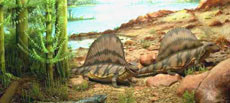 |
 |
 |
 |
 |
Produced
by the Population Genetics and Evolution class, Furman University |
||||
 |
 |
 |
 |
 |
Produced
by the Population Genetics and Evolution class, Furman University |
||||
 |
Dimetrodon
and the Pelycosaurs |
 |
||
| At about 6
feet long, Dimetrodon was a dominant carnivore in the Permian
period. It was a pelycosaur - one of the earliest synapsid groups Schmidt
et al. 2000). Synapids were primitive, egg-laying amniotes that divered
from the more reptilian diapsids (Dinosaur Corporation, 1997). They had
an opening behind the eye-socket used to contain extra muscles for the
jaw, to help facilitate chewing (White and Kazlev 2010). Dimetrodon,
meaning “two shapes of tooth” (AMNH 2010). It was part of
the family called Pelycosaurs, many of whom, like Dimetrodon,
had a large sail on their backs created by a row of long spines growing
out of separate vertebra . The exact function of the sail is not known,
but scientists believe it could have been used in thermoregulation (AMNH,
2010). The most intact fossils found of Dimetrodon are located
in the USA, in Oklahoma and Texas, although Dimetrodon has been
found in Russia and Eastern Europe, as well (White and Kazlev, 2010). Page by Julia Bobo |
 |
| Dimetrodon, from www.planetdinosaur.com on March 17th, 2010. | |
|
American Museum of Natural History. 2010. Dimetrodon. Accessed on March 17, 2010. Dinosaur Corporation. 1997. Dimetrodon .Accessed on March 17, 2010. Schmidt L, Lee J, Mooring R, Rodriguez M, Sullivan S, and Zheng F. 2000. Introduction to the Pelycosaurs. University of California Museum of Paleontology. Accessed on March 17, 2010 White T and Kazlev MA. 2010. Synapsida. www.palaeos.com. Accessed on March 17, 2010. |